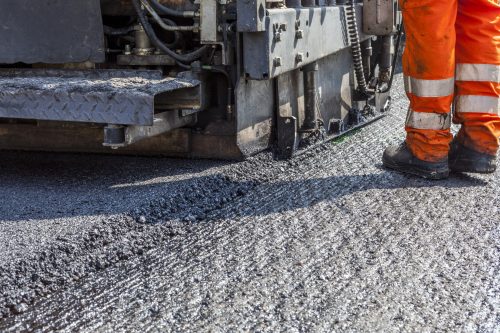The Only Guide for A1 Professional Asphalt & Sealing Llc
The Only Guide for A1 Professional Asphalt & Sealing Llc
Blog Article
All About A1 Professional Asphalt & Sealing Llc
Table of ContentsThe Greatest Guide To A1 Professional Asphalt & Sealing LlcThe Main Principles Of A1 Professional Asphalt & Sealing Llc The Best Guide To A1 Professional Asphalt & Sealing LlcHow A1 Professional Asphalt & Sealing Llc can Save You Time, Stress, and Money.The 5-Minute Rule for A1 Professional Asphalt & Sealing Llc

The oil in a vehicle engine is not simply oil. It includes a selection of additives to boost the car's performance. These consist of polymers, viscosity modifiers, warm stabilizers, additional lubricants, and use additives. The REOB consists of all the additives that remained in the waste oil along with the wear metals from the engine (generally iron and copper).
Nonetheless, by making lots of blends using different REOB examples and various asphalt binders, the variations mainly can be averaged out. Numerous States gave samples of well-known REOB composition to TFHRC researchers, who examined the examples to contrast the portion of included (known) REOB to the found (tested) quantity. The analyses revealed a similar portion of added and found REOB.
A1 Professional Asphalt & Sealing Llc - Truths
None of those States realized that the asphalt they were purchasing included REOB. One State insisted its examples had no REOB - https://alasphaltseal.wixsite.com/a1asphaltseal/post/a1-professional-asphalt-repairs-enhancing-roads-with-excellence.
Of the 1,532 examples tested, 12 percent contained REOB, and some contained appreciably high levels of it at 1020 percent. The highest degree was 34 percent in an example from Texas, which TxDOT had actually utilized in a patching substance. This testing also exposed the visibility of phosphoric acid in 11 percent of the examples, and 2 percent included ground tire rubber.
Two years back at TRB's yearly meeting, the Federal scientists held an REOB workshop and provided the findings of their research laboratory examinations to a standing room-only crowd. Some agencies do not particularly outlaw REOB, they do impose physical tests that avert its useeffectively a restriction. Others do not prohibit it by spec, yet have agreements with asphalt suppliers to avoid the usage of REOB
5 Easy Facts About A1 Professional Asphalt & Sealing Llc Explained
A handful do enable REOB, some within specific limitations. Ohio and Texas limit degrees to much less than 5 percent of the asphalt. To establish a reliable test method that all States can utilize, the TFHRC researchers established a round-robin examination plan. The participants are 11 State freeway firms (Illinois, Massachusetts, Minnesota, Mississippi, Montana, North Carolina, Oklahoma, South Carolina, Texas, Vermont, and Wyoming), 2 independent screening labs, the Ministry of Transportation in Ontario, Queen's College in Ontario, and an Ontario paving specialist.
In overall, the scientists prepared and delivered 720 blends. The individuals are examining the examples independently using the guidelines offered by the TFHRC researchers. The round-robin testing is almost completed, and TFHRC remains in the procedure of gathering the outcomes. The output will be a recommended AASHTO examination method that any kind of State can take on and make use of (a1 asphalt).
The sidewalk with REOB, which is situated 0.6 mile (1 kilometer) from the pavement without REOB, has identical subgrade, traffic thickness, and climate. Nonetheless, the sector of Highway655 with 5 to 10 percent REOB revealed considerable fracturing. In this instance, the visibility of REOB was the recognized reason for breaking at a reduced temperature levels.
"In our experience in copyright, even small amounts of 23 percent can be an issue." A section of examination pavement in Minnesota (MN1-4) discovered to consist of REOB also cracked too soon. The pavement executed well for the initial 3 to 4 years, but after that started to fracture. This sidewalk is also subject to low read the article temperature levels.
The smart Trick of A1 Professional Asphalt & Sealing Llc That Nobody is Discussing
The tests were not substantial, but they revealed that at levels of 6 percent or even more, the tensile strength of the asphalt dropped considerably. At a degree of 3.5 percent REOB, the variant in the physical examination techniques was better than the effect of REOB. It was challenging for scientists to evaluate whether REOB was present. https://a1professionalasphaltandsealin.godaddysites.com/f/a1-professional-asphalt-sealing-llc-expert-asphalt-repairs-an.

One binder parameter taken into consideration is the difference between the reduced temperature level critical requirements temperature level for tightness (S) in the flexing beam rheometer and the flexing light beam rheometer creep incline (m-value) kept in mind as Tcritical. TC = TC (S) TC (m-value). Assessment of this criterion is still recurring. Two independent research study teams, one from AASHTO and the other from the Asphalt Institute, concluded that more research is required on using REOB in asphalt.
Previously, all asphalt screening determined design properties such as stiffness. These examinations do disappoint what materials had been included to the asphalt. One sample received during the TFHRC research study had a very strange analysis. The example had the complying with examination outcomes: Superpave PG 64-28 with a high temperature level quality of 67.3 Tcritical on the flexing beam rheometer was 6.7 levels Celsius.

How A1 Professional Asphalt & Sealing Llc can Save You Time, Stress, and Money.
These outcomes demonstrate there are weaknesses in the standardized engineering testing procedures that may be made use of. The producer might have a financial advantage and the product passes all the standardized examinations, yet the product may not be advantageous to guaranteeing lasting efficiency. To address this issue and the expansion of brand-new asphalt additives and extenders, TFHRC is beginning a research program to utilize handheld spectroscopic tools, x-ray fluorescence spectroscopy, and Fourier change infrared spectroscopy to allow analyses to be done in the field as opposed to needing to take examples back to the lab.
Report this page